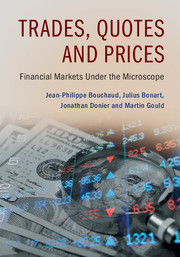Book contents
- Frontmatter
- Dedication
- Contents
- Preface
- Acknowledgements
- PART I HOW AND WHY DO PRICES MOVE?
- 1 The Ecology of Financial Markets
- 2 The Statistics of Price Changes: An Informal Primer
- PART II LIMIT ORDER BOOKS: INTRODUCTION
- PART III LIMIT ORDER BOOKS: MODELS
- PART IV CLUSTERING AND CORRELATIONS
- PART V PRICE IMPACT
- PART VI MARKET DYNAMICS AT THE MICRO-SCALE
- PART VII ADVERSE SELECTION AND LIQUIDITY PROVISION
- PART VIII MARKET DYNAMICS AT THE MESO-SCALE
- PART IX PRACTICAL CONSEQUENCES
- Appendix
- Index
- References
2 - The Statistics of Price Changes: An Informal Primer
from PART I - HOW AND WHY DO PRICES MOVE?
Published online by Cambridge University Press: 26 February 2018
- Frontmatter
- Dedication
- Contents
- Preface
- Acknowledgements
- PART I HOW AND WHY DO PRICES MOVE?
- 1 The Ecology of Financial Markets
- 2 The Statistics of Price Changes: An Informal Primer
- PART II LIMIT ORDER BOOKS: INTRODUCTION
- PART III LIMIT ORDER BOOKS: MODELS
- PART IV CLUSTERING AND CORRELATIONS
- PART V PRICE IMPACT
- PART VI MARKET DYNAMICS AT THE MICRO-SCALE
- PART VII ADVERSE SELECTION AND LIQUIDITY PROVISION
- PART VIII MARKET DYNAMICS AT THE MESO-SCALE
- PART IX PRACTICAL CONSEQUENCES
- Appendix
- Index
- References
Summary
If you are going to use probability to model a financial market, then you had better use the right kind of probability. Real markets are wild.
(Benoît B. Mandelbrot)During the past 40 years, financial engineering has grown tremendously. Today, both the financial industry and its regulators rely heavily on a wide range of models to address many different phenomena on many different scales. These models serve as tools to inform trading decisions and assess risk in a diverse set of applications, including risk management, risk control, portfolio construction, derivative pricing, hedging, and even market design.
Among these models, the most widely used are those that seek to describe changes in an asset's price. Given their prominence, it is important to consider the extent to which these models really reflect empirically observed price series, because models whose assumptions are at odds with real markets are likely to produce poor output. Also, because so much of the modern financial world relies on such models so heavily, widespread application of unsuitable models can create unstable feedback loops and lead to the emergence of system-wide instabilities. For example, the severe market crash in 1987 is often attributed to the prevalence of models that assumed independent Gaussian price returns, and thereby severely underestimated the probability of large price changes. Bizarrely, financial crises can be induced by the very models designed to prevent them.
Market crashes serve as a wake-up call to reject idealistic simplifications and to move towards a more realistic framework that encompasses the real statistical properties of price changes observable in empirical data. Despite considerable recent effort in this direction, this goal remains elusive, due partly to the fact that many of the statistical properties of real price series are highly non-trivial and sometimes counter-intuitive. These statistical properties are called the stylised facts of financial price series.
The aim of this chapter is to provide an informal introduction to the most important of these stylised facts. In addition to being interesting in their own right, these stylised facts constitute a set of quantitative criteria against which to evaluate models’ outputs. As we discuss throughout the chapter, a model's inability to reproduce one or more stylised facts can be used as an indicator for how it needs to be improved, or even as a reason to rule it out altogether.
- Type
- Chapter
- Information
- Trades, Quotes and PricesFinancial Markets Under the Microscope, pp. 22 - 40Publisher: Cambridge University PressPrint publication year: 2018



